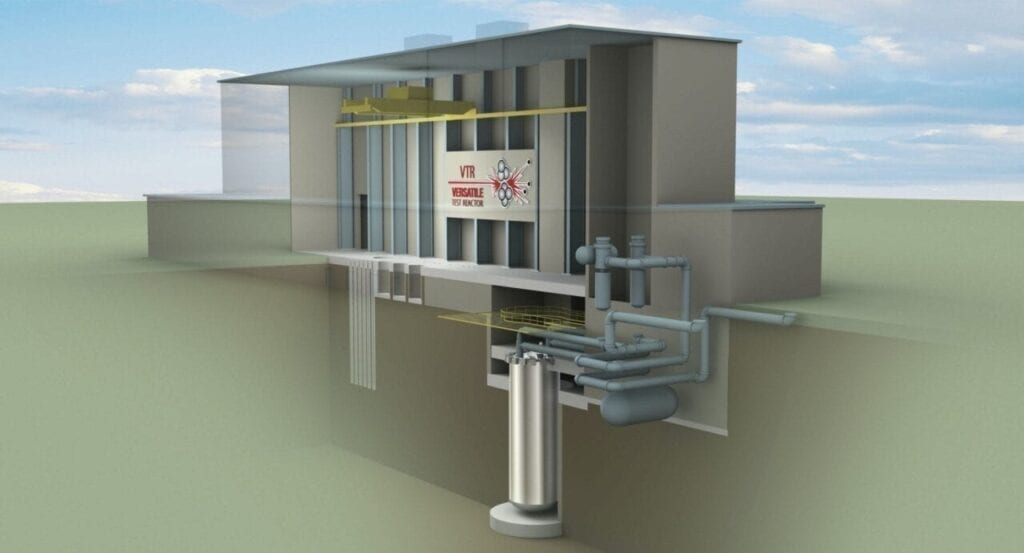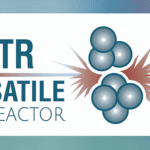Battelle Energy Alliance (BEA), the entity that manages Idaho National Laboratory (INL), has initiated contract negotiations with a team lead by Bechtel National Inc. (BNI) and supported by GE Hitachi Nuclear Energy (GEH) and Terra Power to back the design and build phase of the Department of Energy’s (DOE’s) Versatile Test Reactor (VTR).
The announcement follows a review process of submissions by industry teams in response to a request for proposals (RFP) issued earlier this year. The RFP followed a November 2019–issued expression of interest (EOI), which BEA issued to gauge stakeholder interest in forming a cost-sharing partnership arrangement to design and construct the experimental fast neutron nuclear reactor.
The DOE officially launched development of the VTR in 2018, after Congress passed the Nuclear Energy Innovation Capabilities Act (NEICA), a law that highlights the need for a reactor-based fast neutron source. The law authorized the DOE to proceed on the project it conceived in February 2017. Documents suggest the agency is working to accelerate the VTR program because it is considered necessary to keep the U.S. technologically competitive with China and Russia. The DOE wants the facility to be operational in 2026.
Last year, the DOE estimated the VTR could cost $3 billion to $6 billion, based on similar projects. However, on Monday, BEA noted that a team of experts from INL and five additional national laboratories (Argonne National Laboratory, Los Alamos National Laboratory, Oak Ridge National Laboratory, Pacific Northwest National Laboratory, and Savannah River National Laboratory), 19 universities, and nine industry partners are still developing a conceptual design, cost estimate, and schedule for the VTR.
The INL-led team is also supporting the development of an Environmental Impact Statement (EIS) that will be used to assist the DOE in making the final decision on the design, technology selection, and location for the VTR. The national laboratory suggests a final decision on the VTR is expected in late 2021.
Progress Despite Some Headwinds
But as INL’s recent monthly status reports for the VTR project suggest, the project has suffered headwinds, including over public funding. While the DOE has asked for $295 million to fund the VTR, the U.S. House Appropriations Committee recommended $240 million for Advanced Reactor Demonstrations in FY2021, which is about $10 million above the FY2020 enacted amount. However, the committee in July sharply reduced VTR construction funding below the requested amount, recommending $65 million, about the same as the FY2020 appropriation for pre-construction activities.
“Patience. Everyone’s patience is getting tried,” noted Tom O’Connor, the VTR federal program director in the June 2020 VTR monthly status report. “We submitted a very high quality Critical Decision (CD)-1 package, and even with the cost range adjustments due to the Independent Cost Review (ICR) and the Project Risk Management Committee (PMRC), we are still waiting on the headquarters machinery to perform the last review by the Energy Systems Acquisition Advisory Board (ESAAB),” he said. “And yes, the process has been complicated by driver fuel considerations. FY 2021 budget considerations, in light of our request for $295 million, are uncertain.”
O’Connor suggested, however, that technical triumphs “are translating very positively into the FY2022 budget process.” He told the VTR team: “Everything you are doing is laying a solid foundation for VTR’s success.”
According to Mark Peters, INL director, the start of negotiations with the Bechtel-led industry team to support design and build of the VTR is a big step for the project. “We received excellent proposals from industry, which is indicative of the support to build a fast-spectrum neutron testing facility in the United States,” he said on Aug. 24. “We are excited about the potential for working with the BNI-led team. They will bring a lot of design and construction expertise to the VTR project. This is essential since it has been several years since we built a test reactor in the United States.”
Fostering Nuclear Energy Research
The DOE has suggested the VTR will foster experiments with much higher neutron energy and flux compared to the nation’s existing 35 research reactors, which would help develop advanced nuclear fuel for future nuclear power plants in the U.S.
“Advanced reactors hold great promise, but their fuels and materials need proper testing before they can be licensed and used in energy-producing reactors,” Barbara Rusinko, president of Bechtel’s Nuclear, Security & Environmental global business unit, noted on Monday. However, the U.S. currently has no capability to test these components, which is why the VTR is “extremely important for the science community, industry, regulators, and the future of nuclear energy research,” she said.
In the past, the DOE has suggested that the VTR will likely be a sodium-cooled pool-type fast reactor (SFR) that will use fuels with metallic alloys, including high-assay low-enriched uranium (HALEU) fuel. Documents show that recent VTR designs called for a plutonium/uranium/zirconium (Pu/U/Zr) metal alloy fuel. Initial studies assumed that the source of Pu would be from excess weapons-grade material, with a nominal enrichment of 93.5% Pu-239 and a minimal americium content (~0.5%). However, competition for the available supply of this material has led to consideration of other materials, including lower-grade metals, fuel-grade and reactor-grade oxides as potential feed for fuel fabrication.
A 3-D Overview of the Versatile Test Reactor. Source: DOE
It is unclear whether the final design will be based on the conceptual design the DOE selected in November 2018 from a team comprising GEH and Bechtel. That announcement specifically pointed to a role for GEH’s PRISM technology to support the VTR program. Terra Power says it has supported the VTR program by making enhancements to the VTR’s design and has invested 10 years of sodium technology development into its traveling wave reactor. According to BEA, GEH/Bechtel’s conceptual design work is expected to be completed “when the preliminary/final design phase of VTR commences (after Critical Decision 1 is achieved and capital acquisition funding is available starting in [fiscal year] 2021).”

INL, notably, is also exploring building a “Zero Power Physics Reactor” (ZPPR) test bed to enable testing of microreactor demonstrations and small nuclear prototypes. On Aug. 19, INL issued an EOI from prospective engineering firms to develop a reactor demonstration test bed that could consist of multiple facilities, including two at its Materials and Fuels Complex. It is also exploring using the Experimental Breeder Reactor-II Dome as a possible host site “to accelerate timelines” for demonstration of reactor concepts, including HALEU concepts.
In May, the DOE announced it would provide $160 million in the first year of funding to industry to build two reactors that can be operational within the next five to seven years. The period to submit applications to the Advanced Reactor Demonstration award closed on Aug. 19.
Urgency Rooted in International Developments
According to the Generation IV International Forum (GIF), a collaboration between 13 countries seeking to develop the research necessary to test the feasibility and performance of fourth generation nuclear systems, if built, the VTR will join only a handful of sodium-cooled fast reactors (SFR) that are currently operational or planned.
SFR designs and their associated fuel cycles rely heavily on technologies already developed and demonstrated in several countries, GIF noted. “Overall, approximately 400 reactor years of operating experience have been logged on SFRs, including 300 years on smaller test reactors and 100 years on larger demonstration or prototype reactors. Significant SFR research and development programs have been conducted in the United States, Russia, Japan, France, India, and the United Kingdom,” it said.
However, only two SFR power reactors are currently in operation: Russia’s 560-MW BN-600 at Beloyarsk 3—which has “reliably operated since 1980 with a 75% capacity factor”—and the 820-MW BN-800 at Beloyarsk 4, which began commercial operations in 2016. Currently operating test reactors include Russia’s BOR-60, and China’s first lead-bismuth alloy zero power subcritical reactor, Qixing (Venus) III, which achieved its first criticality in October 2019.
Several test reactors are also under construction or in planning, according to the International Atomic Energy Agency’s (IAEA’s) Aug. 17–released Nuclear Technology Review 2020.
Japan’s JOYO test reactor, for example, is in the licensing process for restart, and Russia is making headway on the Multipurpose Fast Research Reactor (MBIR), which will replace the experimental BOR-60 in 2024. Russia’s lead-cooled BREST-OD-300 and lead-bismuth-cooled SVBR-100 are meanwhile in the licensing process. China’s CEFR (China Experimental Fast Reactor) is also slated to start operation around 2025, and India, which is building the 500-MW Prototype Fast Breeder Reactor (PFBR), is conducting advanced commissioning tests, and imminently expects to reach first criticality.
—Sonal Patel is a POWER senior associate editor (@sonalcpatel, @POWERmagazine).










